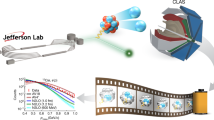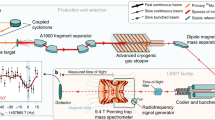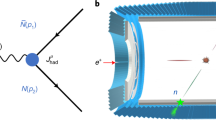Abstract
THE probability density of finding the last neutron and proton in a nucleus in a deuteron state is called the deuteron width in the nucleus. It is therefore directly proportional to the product of single particle fractional parentage coefficients1 for the separation of the neutron and proton from the nucleus. The other factor building up the width is the statistical weight2, which may be obtained as follows. The product of the wave functions of the last neutron and the last proton may be rewritten in terms of the relative and centre of mass co-ordinates of these particles. Multiplying the product with a suitable deuteron wave function of the Hulthen type, say, and integrating over the relative co-ordinate, one obtains the wave function of the deuteron moving about the core. The statistical weight can be obtained once this wave function is known. This prediction is based on the independent particle model of the nucleus.
This is a preview of subscription content, access via your institution
Access options
Subscribe to this journal
Receive 51 print issues and online access
$199.00 per year
only $3.90 per issue
Buy this article
- Purchase on Springer Link
- Instant access to full article PDF
Prices may be subject to local taxes which are calculated during checkout
Similar content being viewed by others
References
Jahn, H. A., and Van Wieringen, H., Proc. Roy. Soc., A, 209, 502 (1951). de-Shalit, A., and Talmi, I., Nuclear Shell Theory (Academic Press, New York, 1963).
Smirnov, Y. F., and Chlebowska, D., Nuclear Physics, 26, 306 (1961).
Smirnov, Yu F., Nuclear Physics, 27, 177 (1961).
Banerjee, M. K., Nuclear Spectroscopy Part B (edit. by Ajzenberg-Selove, F.), 695 (Academic Press, New York, 1960).
Elton, L. R. B., Nuclear Sizes (Oxford University Press, 1961).
British Association for the Advancement of Science, Tables of Circular and Hyperbolic Functions, 1 (Cambridge University Press, 1951).
Author information
Authors and Affiliations
Rights and permissions
About this article
Cite this article
KUMAR, A., BYE, BH. Deuteron Width. Nature 218, 1045–1046 (1968). https://doi.org/10.1038/2181045a0
Received:
Issue Date:
DOI: https://doi.org/10.1038/2181045a0
Comments
By submitting a comment you agree to abide by our Terms and Community Guidelines. If you find something abusive or that does not comply with our terms or guidelines please flag it as inappropriate.



